In a world where content is king, mastering the art of conversion copywriting is like having the secret sauce that transforms mere words into powerful persuasion tools, captivating audiences and driving them to take action.
If your copy isn’t driving conversions, you might be missing a special ingredient…a secret sauce, if you will. It’s called conversion copywriting.
Just like how Alfredo Linguini didn’t know what was missing in his ratatouille, conversion-centered copywriting might be the secret sauce you’re missing. It’s the best way to take your flavorless copy and turn it into something that captivates your audience’s attention and gives them a taste of what’s to come.

Crafting copy that converts isn’t a stroll through the park, and just like Alfredo Linguini discovered, whipping up a delectable dish isn’t a piece of cake either.
That’s why we’re here to unveil the insider tips and tricks that’ll elevate your copywriting game to Michelin star status.
From irresistible headlines to compelling calls to action, we’ve got you covered with practical advice and real-world examples that’ll have you converting like a pro in no time. So grab your metaphorical pen and paper, and let’s dive into the wonderful world of conversion copywriting together.
What is conversion copywriting?
Conversion copywriting is the strategic practice of writing persuasive content specifically designed to get readers to take a desired action. It combines psychology, audience research, and clear messaging to transform casual readers into leads or customers through compelling calls to action.
At its core, copywriting is about persuasion. But conversion copywriting takes this further by focusing entirely on the end goal: getting people to click, sign up, download, or buy.
Think of it like this:
Regular copywriting tells a story, but conversion copywriting tells a story that ends with the reader doing exactly what you want them to do.
When you’re writing copy that converts, you’re carefully structuring information to guide more readers toward taking that specific action. Whether you want them to download your latest ebook or purchase your new product, conversion copywriting gives them the exact information they need—in the exact right order—to feel confident making that decision.
So how does conversion copywriting differ from regular copywriting?
It’s all about intention and measurement. Conversion-focused copy isn’t just well-written—it’s strategically crafted to overcome objections, highlight benefits (not just features), and create a clear path to action. And most importantly, its success is measured in conversion rates, not just engagement or readability.
“To convert is to be.”
Maybe not exactly what Jean-Paul Sartre said, but in 2025 it might as well have been. Because when it comes to your website, emails, or landing pages, conversion isn’t just a nice bonus—it’s the whole point.
What is a conversion copywriter?
A conversion copywriter is a specialist who creates persuasive content designed specifically to drive reader action. They combine psychology, audience research, and persuasive techniques to craft messages that transform visitors into customers.
Unlike general copywriters who might focus on brand voice or storytelling, conversion copywriters obsess over one thing: getting people to click, sign up, or buy. They’re part writer, part psychologist, and part data analyst—tracking what works, what doesn’t, and constantly refining their approach based on real results.
Think of them as the closers of the writing world. They don’t just write pretty sentences—they write copy that sells.
So how do we go about writing copy that will convert? Is there a science to it all?
A step-by-step process to conversion copywriting
Writing high-converting copy may not be easy, but it’s far from impossible. By following these steps, there’s no reason why you can’t write copy that converts your readers. Here are some things to take note of.
1. Get clear on your value proposition
Before diving into the realm of crafting copy that captivates and converts, you must first unravel a series of pivotal questions.
Think of your value proposition like a superhero’s origin story (or an elevator pitch if you’re less imaginative)—it’s the bold declaration of what makes you stand out in a sea of ordinary offerings. But just like a hero needs the right costume for the job, your value proposition needs to suit your audience to a T.
If conversion copywriting is the secret sauce, your value proposition is what flavors every word you write even more. So, before you dive in, make sure you’ve got it all figured out.
Recommended reading: Our guide to figuring out how to write with your value proposition in mind.
2. Understand your audience
As you gear up to craft your high-converting copy, keep in mind that you’re speaking directly to someone specific—those folks you’re targeting with your ads or emailing. Yep, that’s your target audience.
Consider their pain points and the very issues you aim to alleviate with your offer.
If you’re not already familiar with them, consider reaching out to your current customers. What does that look like, you ask?
- Conduct interviews to gain direct insights into how your product or service enhances their lives.
- Consult your sales team to identify which benefits strike a chord with potential customers during discussions.
- Reflect on past marketing endeavors to discern the messaging that yielded the most favorable outcomes. A/B testing, anyone?
Figuring out what messages will click with your target customers can feel like a shot in the dark.You end up relying on stuff like anecdotes and what’s supposed to work, but it’s not exactly rocket science. What can help nail down what copy is working effectively for different audiences is a simple A/B test (more on this later).
For top-notch copy, marketers need hard data that tells them what really gets visitors moving. That’s where we step in with the Conversion Benchmark Report.
3. Identify your conversion goal
The work doesn’t stop there once you’ve got your value prop. What is the goal of the copy you’re writing? Yeah, yeah, the main goal is to convert. But is your copy delivering the message you need properly? No matter what medium your copy exists on, whether it’s a landing page, Facebook ad, email, or a friggin’ billboard, it should have one clear goal it’s trying to achieve.
4. Outline your information hierarchy
Information hierarchy is like the master plan of your copy—deciding which details hold the most sway in persuading your readers to convert and arranging them in a logical sequence.
To tackle it with finesse, consider reverse engineering your objective. Picture the action you’re aiming for, then strategize on how to nudge your readers towards it. What perks of your offer pack the most punch? And what potential hesitations might crop up—and, better yet, how do you squash them?
Now, let’s unfurl a simple roadmap for your information hierarchy. It’s the essential checklist to guide your readers down the conversion path:
- Pain points
What challenges does your offer solve for the reader, and how does it make their lives easier or better? - Benefits
What doors does your product or service swing open for people? What tangible benefits do they derive, and what value does it bring to their lives? - Differentiators
What sets your offer apart? Does it outshine the competition? And, most importantly, does it swoop in like to solve your audience’s woes, making their lives easier? - Objections
Why might people not accept your offer? What could be preventing them from acting? You can be biased towards your creation all you want, but a moment of frankness can set you up for a less rocky path with your audience. Let that inform your copy.
Try listing out things under each of these categories, being as specific as possible. When you’re finished, you’ll have a good idea of what needs to be in your copy in order to get people to act.
5. Start thinking about how you can incorporate your value proposition into your copy
Now that you know what your value proposition is, what your copy goals are, and understand your audience, it’s time to actually incorporate your value proposition into your copy.
But how? Here’s an example.
Let’s say you’re promoting a meal kit delivery service focused on locally sourced, organic ingredients. While the quality of ingredients and their origins are significant selling points, they alone don’t constitute your value proposition.
Instead, highlight the convenience and sustainability of your service to resonate with your target audience. Something like “Enjoy farm-fresh meals delivered straight to your door (and help support local growers along the way).” Boom.
If someone skims your copy and can’t figure out your value proposition within a few seconds, they’re going to bounce. You want to make them Unbounce.
All that to say, make sure your value proposition is clearly communicated at the top of your copy (usually in your headline and sub-headline, if there is one) and reinforced throughout the rest of your copy.
6. Start writing (attention-grabbing) copy
Are you ready to make that delicious stew of copy yet? No better time than the present, they say.
You’ve strategized your information hierarchy and mapped out your copy. Now, it’s time to dive into the nitty-gritty—and the copywriting is where the magic begins.
Whether you’re writing copy for a landing page, an email, social media, or a billboard (go you!), some universal rules are at play that you can use to jazz up your copywriting. Let’s get into some of the key pointers.
Write an effective headline or hook
Strong openers are the rockstars of your copy (whether that’s a headline or a strong opening line). The bold opening act grabs attention and sets the stage for your offer. A killer headline can make visitors go from “I could live without this” to “I can’t believe I stumbled upon this gem”.
When your opening copy falls flat, readers are more likely to bounce. But with short-form copy that packs a punch, you’ll keep them hooked and ensure all your hard work in getting them there pays off big time.
The good news is, if you’ve been following along to this point, you’ve pretty much already written some of your opening copy—because it should be a reflection of your value proposition.
Instead of getting stressed about writing a perfect headline or opening line, focus on nailing the value proposition in the simplest way possible. That’s always a good place to start.
Reinforce your opening copy
Once you’ve written your headline or opening short-form copy, think about backing it up with a supporting headline or copy.
Supporting copy is like your headline’s trusty sidekick. In a landing page, for example, your supporting copy (or sub-headline, if you have one) goes just underneath the headline, expanding on what you said in your headline to clarify your offer or reinforce it with another persuasive message.
This is your opportunity to convey any important information that you couldn’t squeeze into your headline or opening line. (In fact, discarded headlines often make strong supporting copy.)
Refer back to your information hierarchy. Is there a can-not-miss benefit or differentiator you can mention that will capture visitor attention and move them down into your body copy? That’s a potential supporting copy moment.
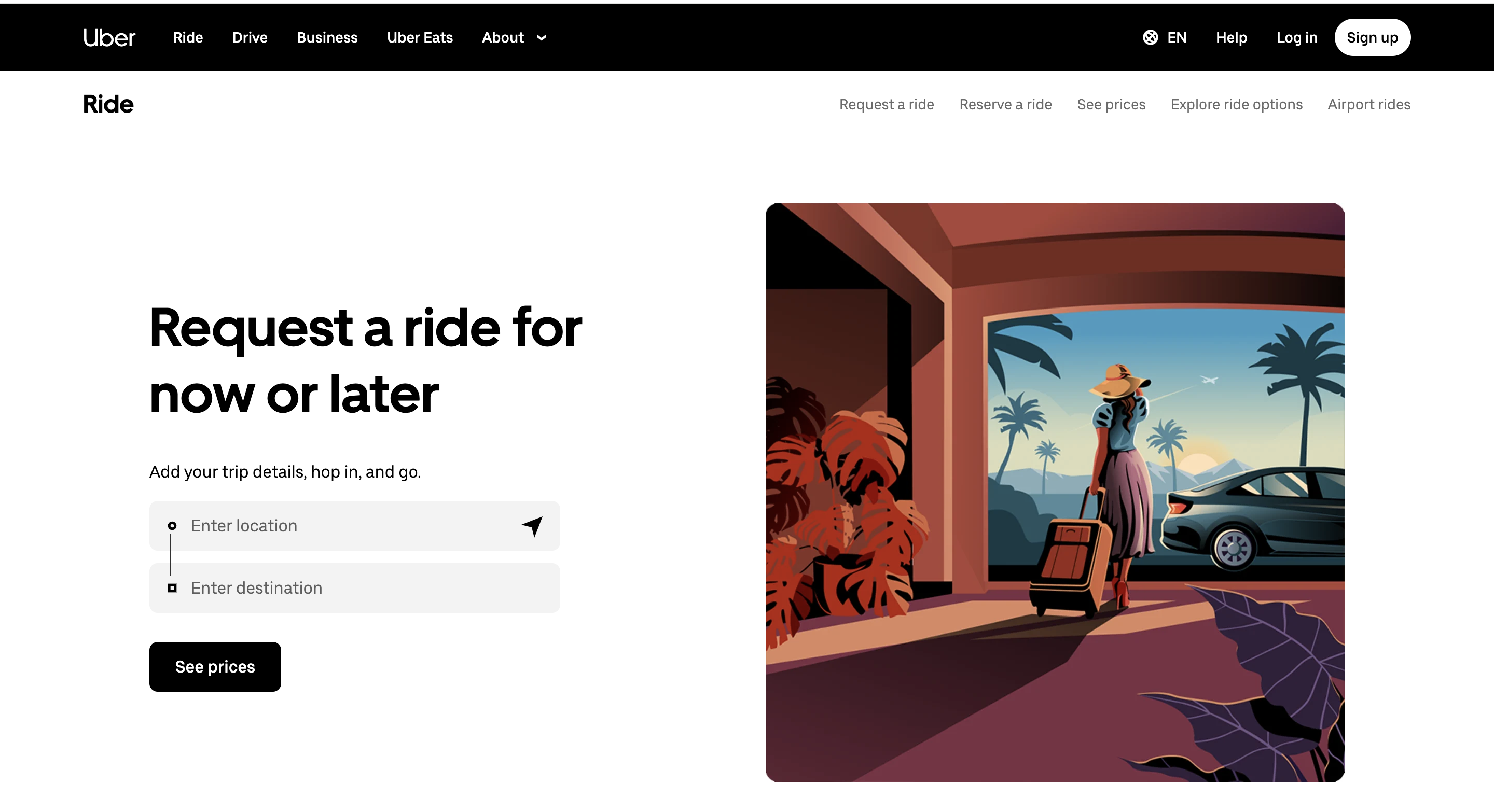

Just look at how Uber does it here. Adding in “Add your trip details, hop in, and go” is a great complimentary piece of copy to “Request a ride for now or later”.
Supporting copy can take on different forms. If you’re writing an email, you’re looking at the copy right below your opening line. If you’re writing an ad, you’re probably looking at a headline and a supporting description. So take the advice and apply it to whatever you’re writing, no matter the canvas.
Write effective body copy
After you nail your headline, your body copy is where the true meat of your message should lie. It should expand on your headline in a way that’s consistent.
But body copy doesn’t equal boring copy. The magic sauce of conversion-focused copywriting lies in its pizzazz. You must remain engaging, even in longer-form copy.
If you want to get your mojo going, give the 4-U formula a spin. Crafted by copywriting wizard Michael Masterson, this magic mix guarantees your copy hits the bullseye with four key ingredients. Hit at least three, and you’re in the sweet spot. Here’s the lowdown:
Usefulness: Does your copy spell out the problem you’re solving and show how your offer makes life better for potential customers?
Uniqueness: Does it outshine the competition with something fresh and fabulous?
Urgency: Are you giving your visitors a nudge to act now, not later?
Specificity: Are you clearly laying out the juicy benefits your readers get?
Truth is, you can apply this formula anywhere in your copy.
Once your body copy has these qualities and is hitting these points, you can start to get more granular. The following focus areas are crucial for effective, high-converting body copy.
The power of a high-converting copy is in its ability to bring focus to a campaign, and the body copy and headline should represent that. Avoid vagueness or leaving anything up to interpretation. Get to the point. That’s what body copy is for.
This is in relation to other elements of your campaign (like your traffic source) as well as the rest of your copy. Your copy will be most effective if it flows as a cohesive story—and that starts with your headline.
Making it about your reader
As with all copywriting, your body copy should be about your audience—not about you. Use longer-form body copy to talk about customer benefits to show that you understand your visitors’ needs.
Focusing on benefits, not features
Let’s get it straight: you want to sell the outcome, not the product or service. What that really means is that you want to focus on the benefits, not the features.
If you’re selling a smartphone, features might include the camera specs or battery life. But the benefit is how those features let you capture stunning photos or stay connected all day without recharging. There’s a difference, you see.
TLDR: Your copy should spotlight benefits that underscore your value proposition. Your headline grabs attention with the offer, and your body copy seals the deal by illustrating how you’ll deliver that sweet, sweet value.
7. Apply marketing psychology to your copy
No matter what kind of copy you’re writing, Implementing marketing psychology into your copy can make your copy super impactful. Don’t worry, we’re not talking about tricking people—that’s a surefire way to lose customers in the long run. Instead, think of it as presenting information in a way that naturally appeals to your readers (even subconsciously) and speeds up their path to conversion.
Take the AIDA formula, for example. It’s a classic for a reason. In the realm of copywriting, it helps structure your message to spur readers into action:
- Attention: Start with an attention-grabbing opening line that makes them want to keep reading (which we’ve talked about).
- Interest: Pique their interest by highlighting a crucial pain point or an irresistible benefit.
- Desire: Zero in on how your product or service will deliver the promised value.
- Action: Present a clear call to action, harnessing the momentum you’ve generated to drive the conversion. (More on this in the next point.)
By following this approach, you’ll have a copy that not only attracts but also converts.
8. Write a compelling call to action
So you’ve got your killer opening line or headline, your meaty body copy, and it has compelling information and a sense of urgency to it. The next step? Making sure it all counts for something. You can do this by writing something we like to call a call to action or CTA.
A CTA can take on different forms based on where you’re doing your copywriting. If you’re doing some landing page copywriting, there’s a CTA button that’ll take your reader where you want ‘em. If you’re writing an email, it’s usually a hyperlink you’re guiding folks to. If you’re writing for socials, you’re probably directing folks to a link in your bio.
Whatever the case may be, your CTA is all about making sure all of the copy that came before it lands.
Writing a compelling call to action (CTA) is all about stepping into your visitor’s shoes. Here’s how to make it irresistible:
Be specific: Clearly tell your readers what happens when they act on your CTA. Describe the next step to ease any hesitation or anxiety they might have.
Maintain consistency: Align your CTA messaging with the rest of your copy. Consistent language reinforces your value proposition right up to the conversion point.
Keep it simple: Avoid overcomplicating the conversion process. A straightforward CTA with minimal steps reduces friction and encourages action.
Use action verbs: Inspire readers to act by using dynamic verbs like “get” and “start.” Create a sense of urgency to prompt immediate action by highlighting limited-time offers or awesome outcomes.
By following these tips, you can craft clear, consistent, and compelling CTAs that drive higher conversions and satisfy your reader’s needs. Yay!
9. Use social proof to validate your copy
Word of mouth never goes outta style. Depending on the medium you’re copywriting for, testimonials and social proof from folks who have used your product or service is a great way to vouch for yourself without sounding too self-congratulating.
This can be a simple quote from a satisfied customer towards the end of your email or a review score from a credible source at the bottom of your landing page. The world is your oyster, as long as you’ve got that good reputation.
10. Test your copy
Picture this: You’ve poured your heart and soul into cookin’ up what you believe is the perfect copy. But when it comes to conversions, it’s crickets.
Fear not, dear marketer, for the answer lies in the magical world of A/B testing.
A/B testing can be a sous-chef for your copy, seasoning every sentence until it’s a lean, mean, conversion-generating bite.
You can start right now by using Unbounce’s A/B testing tool to get your landing page copy where it needs to be. Don’t settle for lackluster copy when you can have high-converting brilliance, seriously.
8 conversion copywriting examples (and why they work)
We can talk about how to write high-converting copy as long as you need, but what about we just show you? Here are some great examples to get inspired by.
1. Unbounce: High-converting landing page copy
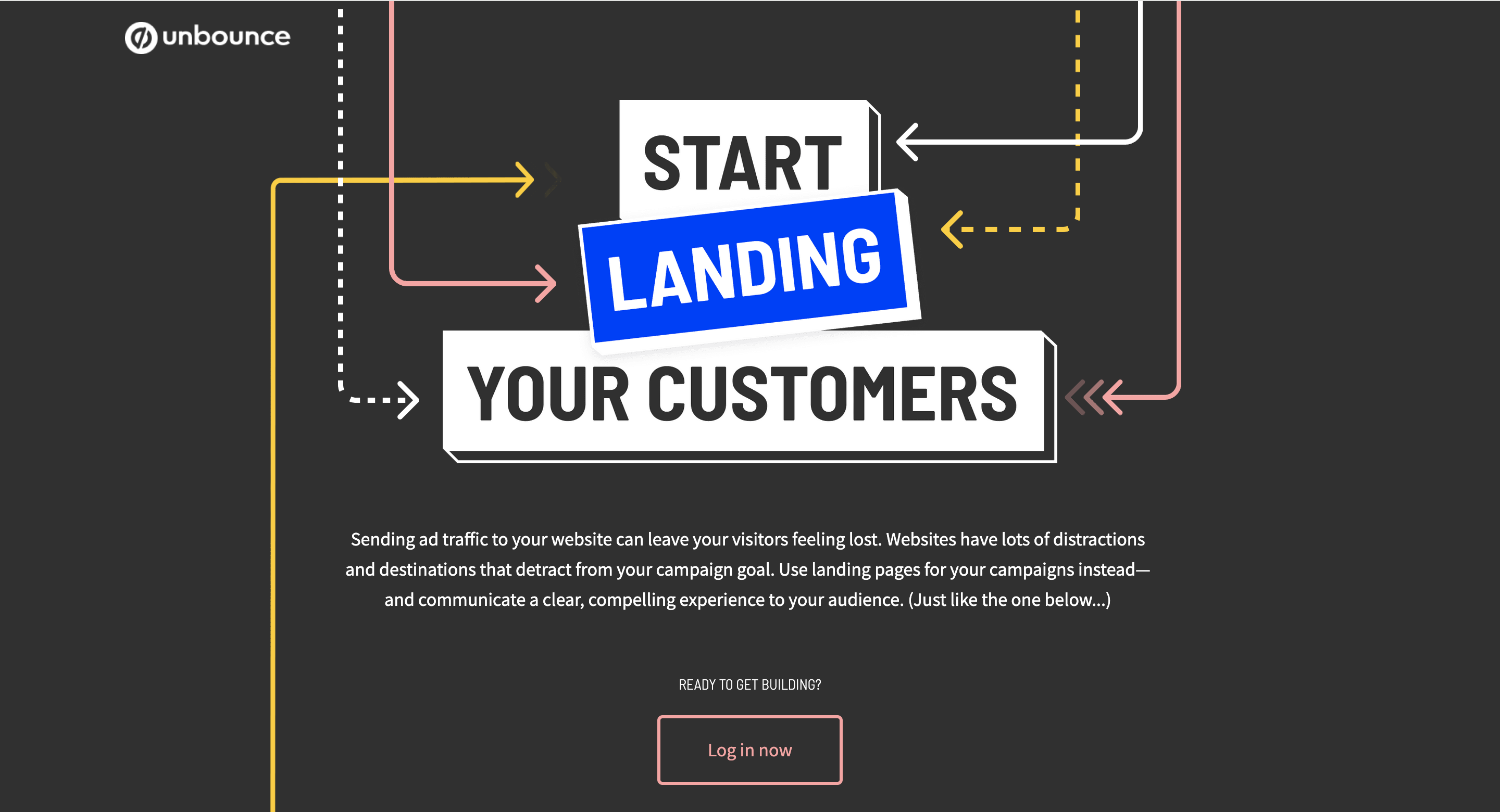

Here at Unbounce, we know all about high-converting landing pages. High-converting copy is an essential part of getting there. With the example above, we follow a simple formula. In the headline, we’re going for the direct results you’d be getting by using Unbounce, and that’s landing your customers.
In the body copy, we first present the problem: Websites can have lotsa’ distractions that can distract from your campaign goals. So what’s the solution? Landing pages.
Want to give copywriting for landing pages a try? Start with Unbounce to build high-converting landing pages, with no need to worry about design or dev skills—so you can pour all your energy into your copy. Plus, you can have access to landing page templates that make things a heck of a lot easier.
2. UNIQLO: High-converting website copy


UNIQLO knows its audience. As a direct-to-consumer brand, they know to put the proper weight behind a day like Mother’s Day. Their website heavily emphasizes this angle, leaving no room for questions or alternative choices.
Copy like “Mother’s Day gifts”, “Find something beautiful for Mom”, and “Give Mom quality, comfort, and style” make for the perfect gateway to conversion for folks who are on the lookout for exactly that.
When we speak of high-converting website copy, this is what we mean, folks.
3. U-HAUL: High-converting billboard copy


U-HAUL doesn’t shy away from a bit of cheekiness. They’ve tapped into the lore around U-HAUL and queer culture. They’re leaning into humor that they know will land with a very specific subset of their audience. It’s like an inside joke with a niche audience. It might feel like a risky move, but U-HAUL is betting on the immediate connection they’ll foster with the queer community by creating this ad. We have a feeling it’ll land.
4. Nothing: High-converting product description copy


Even with all the competition in the tech world, Nothing still stands out from everything else. The way they write about their products oozes passion.
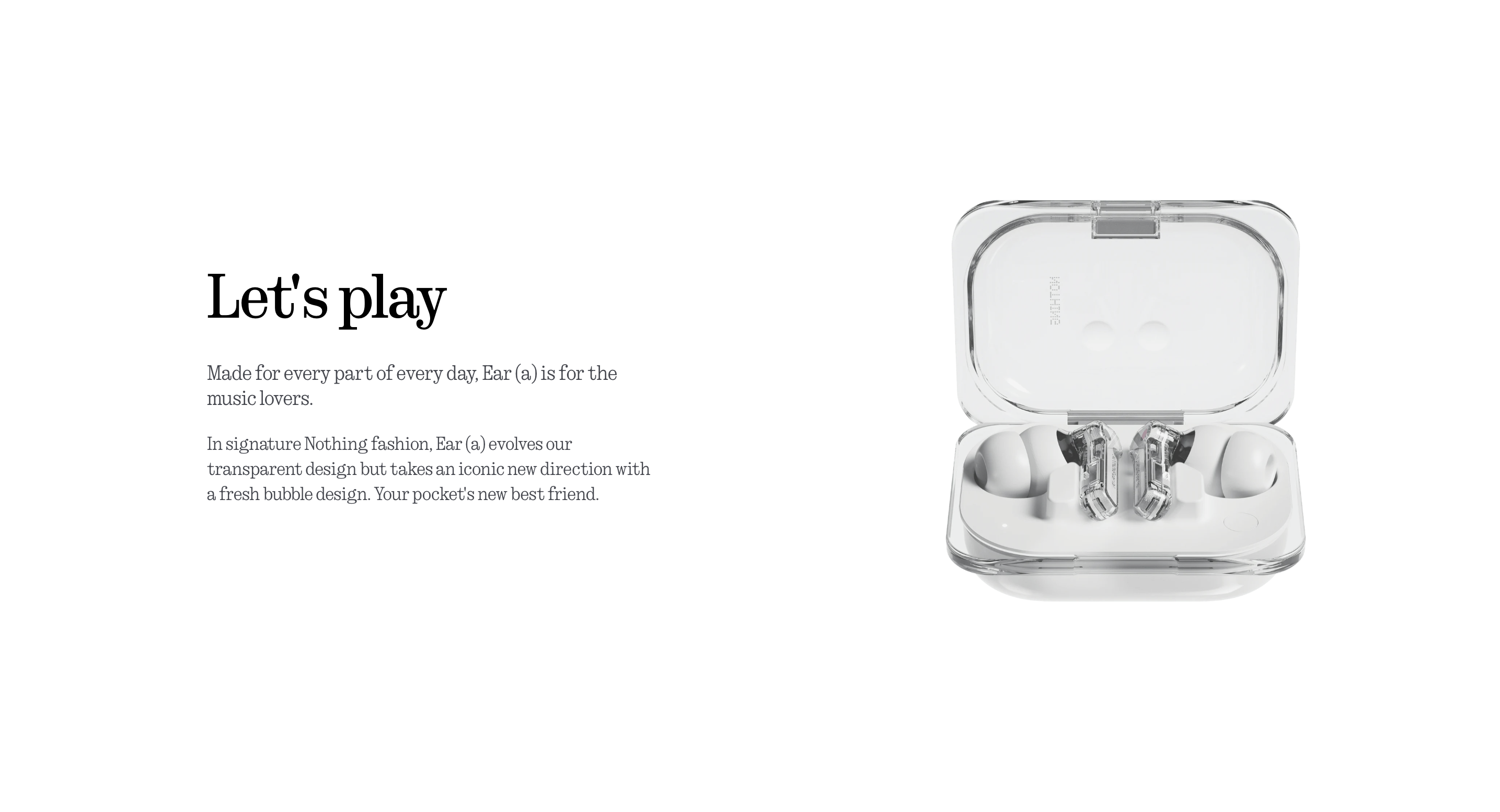

They’re not only telling you what their product is, what features it has, or its design. They’re also writing poetry. “Your pocket’s new best friend” has to be our new favorite line.
5. Canva: High-converting ad copy


As important as landing page copy is, ad copy should match its energy. Canva does a great job of this. From looking at the ad, you’re quickly told that you’ll be in for “thousands of custom templates”. That’s great news! You click on the ad, hoping for the best.


And bam. The landing page before you shows you a slew of template options that you can scroll through, showing you exactly how many possibilities are available to you. “A perfect fit for everyone”, indeed.
That’s how you hold brand promises, people.
Inspired to create copy for your own seamless Google ad? No better place to start than Unbounce’s Google Ads generator. Let’s see what you got.
6. Harvard Business Review: High-converting email copy


Harvard Business Review is a master of the email copywriting game if you haven’t caught wind of that already. They deliver the perfect baits for their vast catalog of work-related material for their audience to dig into, bringing a different subject into focus with each email.
In the example above, they go for an attention-grabbing email subject line. It’s a sensitive topic, to say the least. But instead of sensationalizing it, they go straight to giving you the solution with “Here’s what to do.”
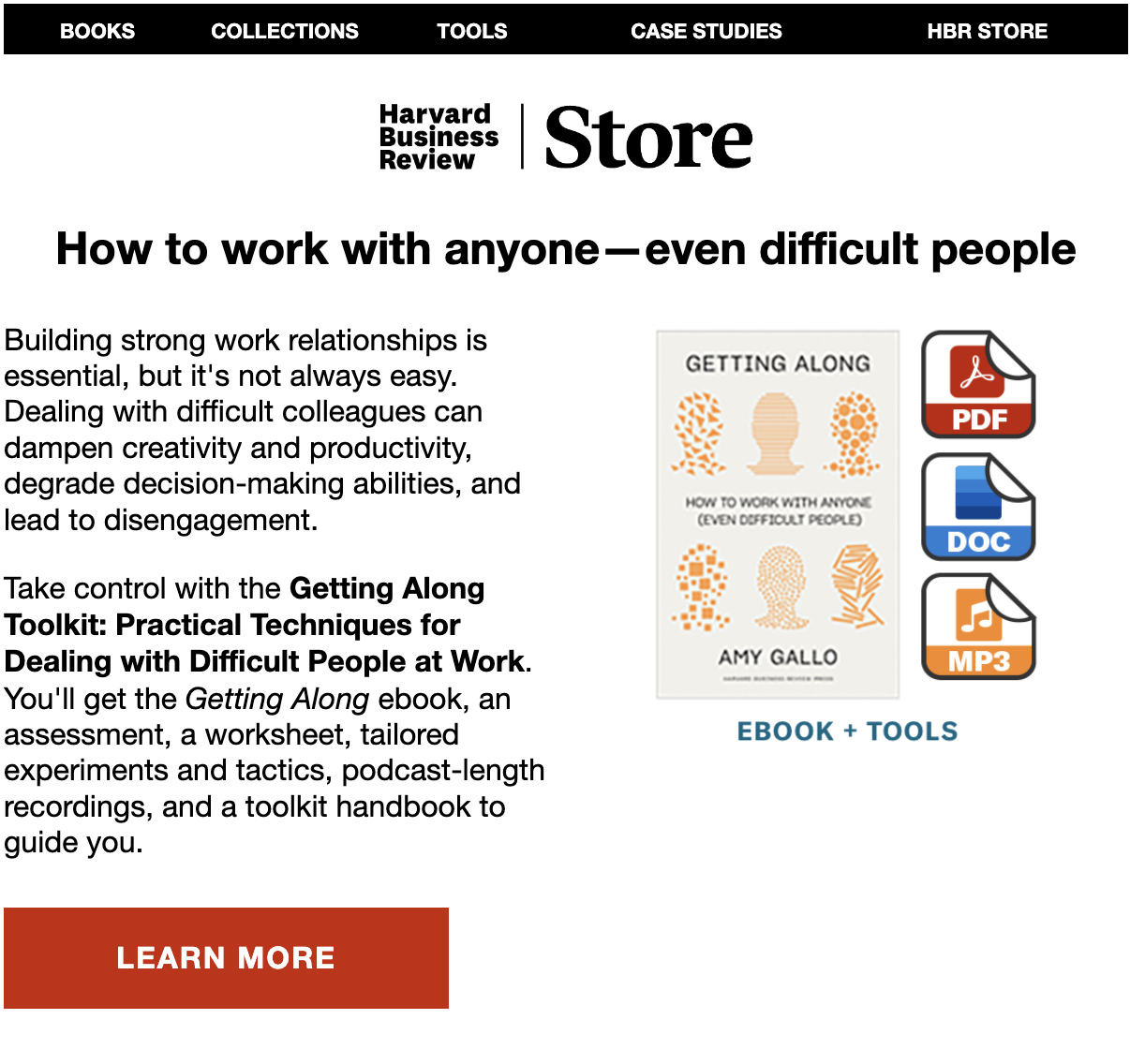

Once you click on the email, it’s nirvana. Even if you’re not going through it with a colleague, the line “How to work with anyone” is relevant to, well, anyone.
Harvard Business Review does the classic: it presents the problem and what could be at stake if you don’t improve your work relationships.
But fear not, they’re coming in clutch with the solution: The Getting Along Toolkit.


HBR doesn’t stop there. After selling you on their key gated content piece, they’ve got more to offer you under the same umbrella. Each piece of copy about their gated content speaks concisely while tying everything back to the main topic of the email: relationships and work. Talk about a meaty email.
7. Zapier: High-converting Facebook copy
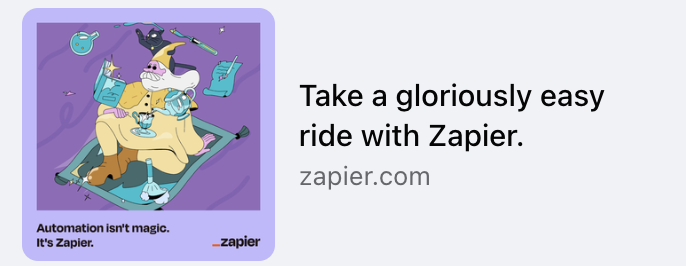

And then there’s Zapier. It’s hard to come by inspired copy on this platform nowadays, but Zapier finds a way to do it. All they need is a magic carpet concept on their side, and they’ve got all they need to take the copy all the way there. They don’t only stick on in-ad copy either, they make sure to nail their in-asset copy too, so that they drive the metaphor home. “Automation isn’t magic. It’s Zapier” is the perfect copy-in-crime for “Take a gloriously easy ride with Zapier.” It all connects, and we love it.
Psst. You can get your Facebook ads to this level. Just give our Facebook text generator tool a try to start creating some magic.
8. Dropbox: High-converting blog copy
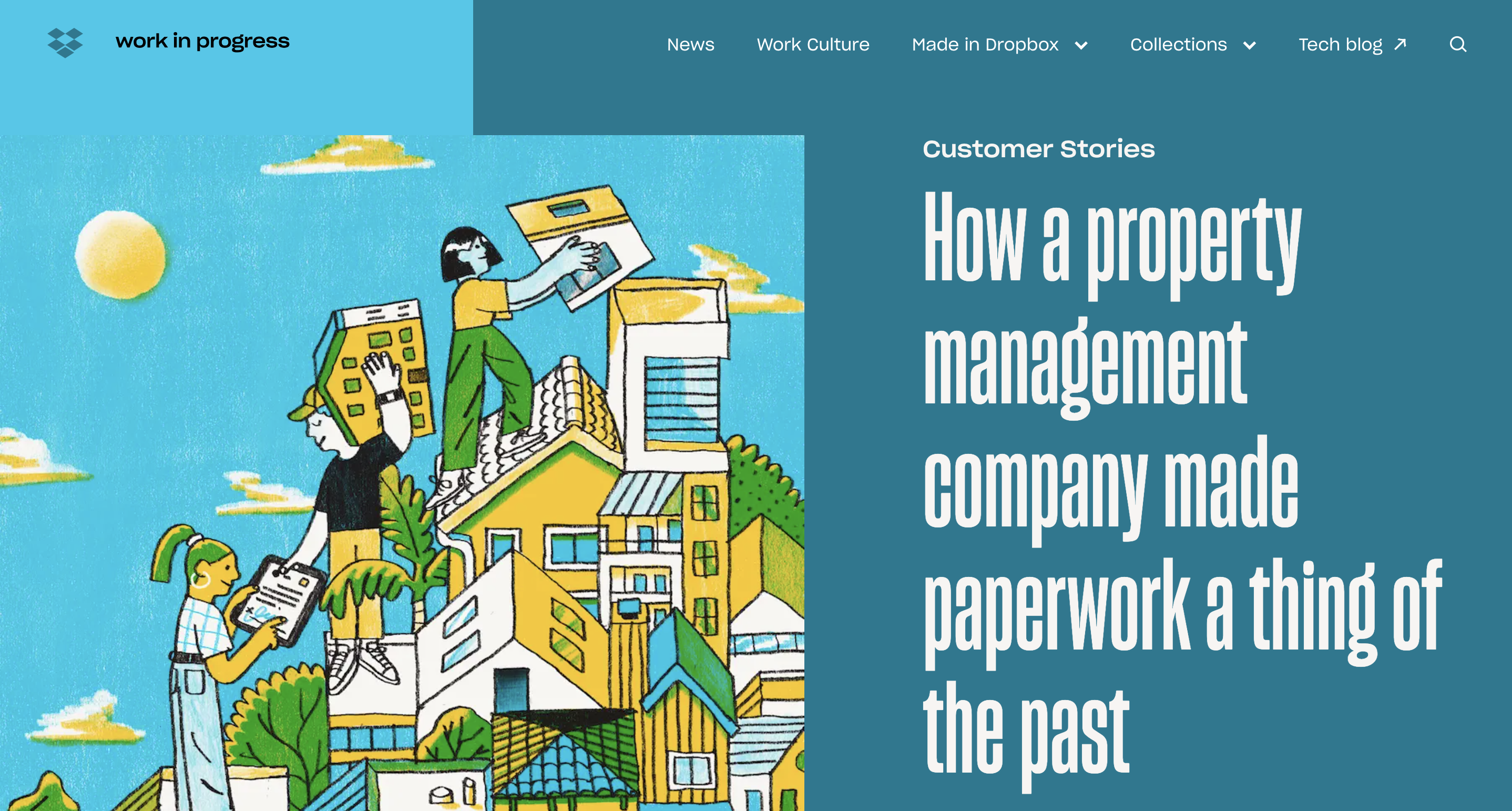

Dropbox’s blog, titled work in progress, is anything but that. It’s designed to pure perfection with copy that resonates with their target audience while delivering diverse content.
Dropbox knows how to draw in their audience with customer stories that resonate. “Making paperwork a thing of the past” is a storyline that many a folk using Dropbox can relate to. When it comes to blog copy, relatability can sometimes mean conversions.


Within their blogs, Dropbox carries the same energy. The story they’ve shared connects directly to one of Dropbox’s main use cases. When this particular customer is “sending links and documents” they’re doing it via Dropbox. And by clicking on this in-line blog link, you’ll be taken to a page where you’re that much closer to converting. Gotta give it to ya, Dropbox.
SUBSCRIBE
Don’t miss out on the latest industry trends, best practices, and insider tips for your marketing campaigns
What is the difference between SEO and conversion copywriting?
Now that we’ve explored some (fantastic) examples of high-converting copywriting, a new question might be forming in your mind: How does SEO (search engine optimization) copywriting differ from conversion copywriting?
Let’s find out.
SEO and conversion copywriting are both key components of any digital marketing effort, but they serve different purposes within the marketing funnel.
SEO copywriting focuses on improving a website’s visibility in search engine results pages (SERPs) by optimizing elements like keywords, meta tags, and backlinks. The goal is to attract more organic traffic by making sure that the website ranks higher for relevant search queries. It’s all about using exact keywords within your copy that you know are going to have an impact on your SEO.
Conversion copywriting, on the other hand, is all about crafting persuasive content that motivates visitors to take specific actions, like making a purchase, signing up for a newsletter, or filling out a form. It uses language and psychology techniques to influence user behavior and drive conversions. (As we’ve learned so far.)
In essence, SEO copywriting brings visitors to the website, while conversion copywriting converts those visitors into customers or leads. SEO copywriting increases traffic, and conversion copywriting maximizes the effectiveness of that traffic.
Think of SEO as dressing to impress for a big party—it’s about getting noticed. Conversion copywriting, however, is the smooth talker who seals the deal once you’re in the room. SEO copywriting gets you there, but conversion copywriting convinces you to stay and engage.
Start writing copy that converts
Mastering the art of conversion copywriting is essential for any successful digital marketing strategy. By focusing on clear value propositions, setting specific copy goals, and deeply understanding your audience, you can craft compelling messages that drive action. Remember, effective conversion copywriting is about persuasion—communicating the right message at the right time to convince your audience to take the desired action.
Now that you have the tools and insights to create high-converting copy, it’s time to put them into action. Start writing your copy, test your copy, and refine your approach to achieve the best results. With a landing page creation and conversion optimization platform like Unbounce and the right techniques, you’ll see your conversion rates soar.








